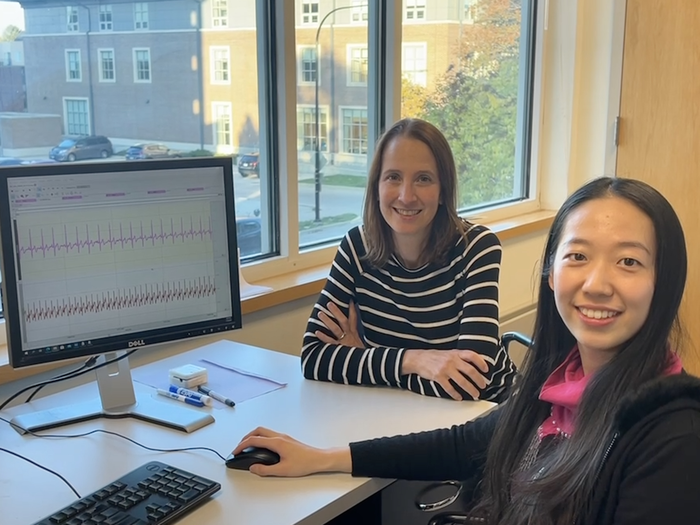URBANA, Ill. – When mothers and their children play together, they instinctively respond to each other’s cues. And positive interactions promote the child’s healthy socioemotional development. A new study from the University of Illinois examines how physiological and behavioral reactions coordinate during mother-child playtime. The findings highlight the importance of responsive communication, and can help provide insights for parents, practitioners, and researchers.

Credit: Xiaomei Li, College of ACES, University of Illinois.
URBANA, Ill. – When mothers and their children play together, they instinctively respond to each other’s cues. And positive interactions promote the child’s healthy socioemotional development. A new study from the University of Illinois examines how physiological and behavioral reactions coordinate during mother-child playtime. The findings highlight the importance of responsive communication, and can help provide insights for parents, practitioners, and researchers.
“Our study measures real-time physiological and behavioral coordination between mothers and children while they’re interacting with each other,” says Yannan Hu, doctoral student in the Department of Human Development and Family Studies at U of I and lead author on the paper. “Researchers consider physiological synchrony beneficial for the child’s socioemotional development. But our study is one of the first to link it to behavioral synchrony.”
The findings show mothers generally lead changes in physiological responses but only for mother-child pairs with high levels of behavioral coordination.
“Overall, when mothers and children are coordinated at the behavioral level – they work together, take turns, and share positive affect – the child’s physiological activity follows the physiological changes in mom,” Hu explains.
The study included 110 mothers and their children, ranging from 3 to 5 years of age. Participants came to a University of Illinois behavioral laboratory for a session of interactive play. Mother and child first worked together for five minutes on solving a 3-D puzzle. Then, then switched to “pet doctor” toys and stuffed animals for another five minutes of pretend play.
During play sessions, the researchers equipped mothers and children with wireless electrodes to measure their parasymphathetic response through high-frequency changes in heart rate, known as respiratory sinus arrhythmia (RSA). They also recorded the play sessions, and trained observers coded mother-child behavioral coordination, including shared smiles and laughter, taking turns, and responding to each other’s social cues.
Positive changes in RSA indicate that mothers and children are socially engaging and moving toward each other, the researchers say, while decreases in RSA are typically observed when confronting a stressor or problem. Thus, increases in the mother’s RSA are likely to indicate increasing engagement with the child, who then reciprocates in turn.
“We measured in real time whether the mom and child are able to coordinate,” Hu says. “This tells us about their interactions above and beyond the mom’s parenting behavior. It not only matters how parents treat their children. Children also need to be responsive to their parents’ cues for the parent and child to establish a coordinated interaction.”
From the findings, parents can learn more about the importance of tuning in to their children’s cues and being responsive to their behaviors during playtime and other interactions.
“Another strength of this study is the focus on mother-child interaction during a positive play context,” notes Nancy McElwain, HDFS professor and co-author on the paper. “Research often focuses on how parents help children regulate negative emotions and behaviors, and this is important. It is equally important, though, to understand how parents and children work together to maintain or increase shared positive interactions and emotions. Play provides an ideal context to understand these positive processes.”
However, the study can also help practitioners spot potential problems for early intervention by identifying less beneficial behaviors, such as interrupting each other, failing to take turns, or ignoring each other’s social cues.
The researchers are expanding their studies to mothers and infants to consider how moment-to-moment behavioral and physiological coordination shapes brain development during the first year of life. They are also planning in-home “virtual” studies that allow for more diverse samples and inclusion of fathers and other caregivers.
The Department of Human Development and Family Studies is in the College of Agricultural, Consumer and Environmental Sciences, University of Illinois.
The article, “Mother–Child Mutually Responsive Orientation and Real-time Physiological Coordination,” is published in Developmental Psychobiology [https://doi.org/10.1002/dev.22200]. Authors include Yannan Hu, Nancy McElwain, and Daniel Berry.
The study was supported by funding from the National Science Foundation (SMA- 1416791) and the USDA National Institute of Food and Agriculture (ILLU-793-362).
Journal
Developmental Psychobiology
DOI
10.1002/dev.22200
Method of Research
Experimental study
Subject of Research
People
Article Title
Mother–Child Mutually Responsive Orientation and Real-time Physiological Coordination
Article Publication Date
21-Oct-2021




